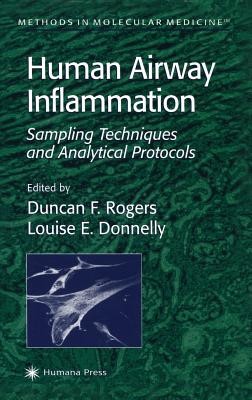
- We will send in 10–14 business days.
- Publisher: Humana
- ISBN-10: 0896039234
- ISBN-13: 9780896039230
- Format: 16 x 23.7 x 2.7 cm, hardcover
- Language: English
- SAVE -10% with code: EXTRA
Human Airway Inflammation (e-book) (used book) | bookbook.eu
Reviews
Description
Rubor (redness), tumor (swelling), calor (heat), and dolor (pain) are the classical signs of inflammation. These features are obvious in the skin, where injury or disease causes flare, wheal, and painful burning sensations. Vasodi- tation underlies the flare and heat, plasma exudation the swelling, and acti- tion of sensory nerves relays pain. In chronic conditions, skin biopsies show inflammatory cell infiltrate. Inflammation is not unique to the skin and contr- utes to disease and repair processes in other organ systems in the body. From the viewpoint of this volume, lung inflammation is now recognized as central to the pathophysiology of a number of severe respiratory conditions, the two most common being asthma and chronic obstructive pulmonary disease (COPD). In asthma, and to a lesser extent COPD, there is evidence of vasodilatation, with congestion of blood vessels accompanied by reddening of the airway mucosa, and of plasma exudation, leading to swelling of the airway wall. Similarly, although less pronounced than in the skin, there is evidence of pain, for example, the - pleasant chest sensations associated with asthma attacks. Understanding the pat- genesis of airway inflammation will enable rational design of drugs to effectively treat conditions such as asthma and COPD. However, whereas immediate access to the skin facilitates investigation of disease processes, the lung, although "open to atmosphere," is much less accessible. Consequently, the investigation of lung inflammation is usually indirect. Thus, a wide variety of research techniques are used.
EXTRA 10 % discount with code: EXTRA
The promotion ends in 18d.13:25:38
The discount code is valid when purchasing from 10 €. Discounts do not stack.
- Publisher: Humana
- ISBN-10: 0896039234
- ISBN-13: 9780896039230
- Format: 16 x 23.7 x 2.7 cm, hardcover
- Language: English English
Rubor (redness), tumor (swelling), calor (heat), and dolor (pain) are the classical signs of inflammation. These features are obvious in the skin, where injury or disease causes flare, wheal, and painful burning sensations. Vasodi- tation underlies the flare and heat, plasma exudation the swelling, and acti- tion of sensory nerves relays pain. In chronic conditions, skin biopsies show inflammatory cell infiltrate. Inflammation is not unique to the skin and contr- utes to disease and repair processes in other organ systems in the body. From the viewpoint of this volume, lung inflammation is now recognized as central to the pathophysiology of a number of severe respiratory conditions, the two most common being asthma and chronic obstructive pulmonary disease (COPD). In asthma, and to a lesser extent COPD, there is evidence of vasodilatation, with congestion of blood vessels accompanied by reddening of the airway mucosa, and of plasma exudation, leading to swelling of the airway wall. Similarly, although less pronounced than in the skin, there is evidence of pain, for example, the - pleasant chest sensations associated with asthma attacks. Understanding the pat- genesis of airway inflammation will enable rational design of drugs to effectively treat conditions such as asthma and COPD. However, whereas immediate access to the skin facilitates investigation of disease processes, the lung, although "open to atmosphere," is much less accessible. Consequently, the investigation of lung inflammation is usually indirect. Thus, a wide variety of research techniques are used.


Reviews